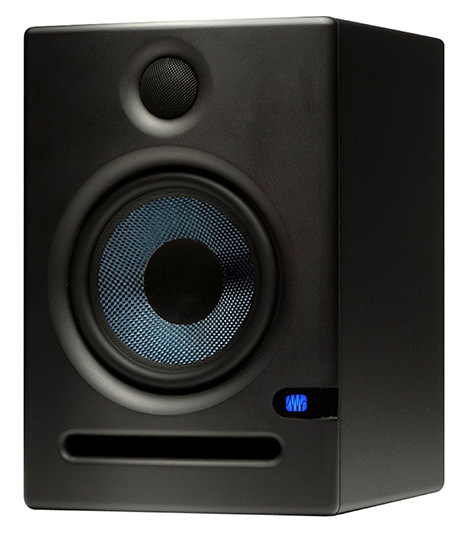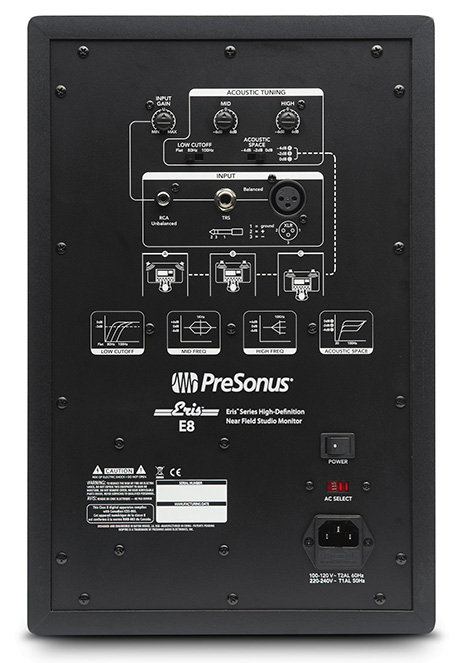- Presonus made their reputation in the '90s and early 2000s offering multichannel compressors and interfaces with innovative features that were also affordable. They have recently made their entry to the monitor game with the new Eris series, which includes the 5.25-inch E5 and the 8-inch E8 high-definition near-field studio monitors. For this review, I tested a pair of the E8 model in a professional facility with properly treated walls.
The Eris monitors are self-powered with a dual amplifier design, one for the Kevlar low-frequency driver and one for the silk dome high-frequency tweeter. The E5 has 45 W behind its low-end and 35 W for the tweeter, achieving 102 dB SPL at peak, while the E8 has 75 W and 65 W, respectively, for a clean 105 dB SPL at its peak. Both monitors are capable of producing up to 22 kHz on the high-end, while the E5 reaches 53 Hz at its low-end limit and the E8 goes as low as 35 Hz. Using a sine wave, I found the E8 lost strength significantly at around 42 Hz, especially when compared to another 8-inch near-field monitor, the Mackie HR824. Below the E8's woofer is a front-firing acoustic port that you can feel a lot of air escaping from. When monitoring a soloed bass drum at a normal level used for EQing, this port gave off a very unpleasant and distracting rumble, making it pretty close to impossible to work with. It wasn't as apparent when I played a full mix, but these speakers do not excel at being turned up loud. That being said, on their own—and in comparison to the Mackies—they did sound very good at moderate levels. Reverbs and other fine details were easy to hear. They actually made some familiar music sound better than I am used to, which may be undesirable if you're looking for something with a flatter response. I found the E8s had some low mids pulled out and smoothed high mids in comparison. This could encourage mistakes in these areas, so users should tread carefully.
 Fortunately, there are many adjustments offered for custom-tailoring to your preference and room. The back panel offers a lot of options for connecting and integrating the Eris monitors to any space. There are balanced 1/4-inch TRS and XLR connectors as well as unbalanced RCA jacks. There is an input level control with 35 dB of gain above unity. An acoustic space switch can be flat, -2 dB, or -4 dB for removing bass in case they're positioned near walls or the corners of a room. A low cutoff switch engages either a flat response or a rolloff of 80 Hz or 100 Hz, with a slope of -12 dB per octave—useful if there's a sub in your setup. There are two EQ knobs on each monitor: a high frequency shelf that is adjustable ± 6 dB above 4.5 kHz and a ± 6 dB mid-frequency peak at 1 kHz. All of these controls help to tune the monitors to a user's room and mixing style, making them more versatile. For example, if mixes are constantly translating as dull in other spaces, the room is probably too bright and cutting some treble in the monitor will encourage you to mix a little brighter to compensate.
Fortunately, there are many adjustments offered for custom-tailoring to your preference and room. The back panel offers a lot of options for connecting and integrating the Eris monitors to any space. There are balanced 1/4-inch TRS and XLR connectors as well as unbalanced RCA jacks. There is an input level control with 35 dB of gain above unity. An acoustic space switch can be flat, -2 dB, or -4 dB for removing bass in case they're positioned near walls or the corners of a room. A low cutoff switch engages either a flat response or a rolloff of 80 Hz or 100 Hz, with a slope of -12 dB per octave—useful if there's a sub in your setup. There are two EQ knobs on each monitor: a high frequency shelf that is adjustable ± 6 dB above 4.5 kHz and a ± 6 dB mid-frequency peak at 1 kHz. All of these controls help to tune the monitors to a user's room and mixing style, making them more versatile. For example, if mixes are constantly translating as dull in other spaces, the room is probably too bright and cutting some treble in the monitor will encourage you to mix a little brighter to compensate.
 On the safety side, the Eris monitors are equipped with several features for better performance and longevity. This includes protection from RF interference, output current limiting, over-temperature, on/off transients, subsonic frequencies and an external mains fuse.
The Eris monitors, while not performing well when pushed, are still a great value. They definitely sound comparable to or better than other speakers in their class and also have plenty of useful features. Being able to tune them is a huge plus, and they're equipped to be connected to pretty much any setup. If I was looking for a something with more powerful bottom, I would probably want to roll off the lows on these and add a subwoofer. But at that point, stepping up to a more expensive unit would be another option. These are certainly worthy of consideration for anyone on a budget.
Ratings:
Cost: 4/5
Versatility: 4/5
Sound: 2.5/5
On the safety side, the Eris monitors are equipped with several features for better performance and longevity. This includes protection from RF interference, output current limiting, over-temperature, on/off transients, subsonic frequencies and an external mains fuse.
The Eris monitors, while not performing well when pushed, are still a great value. They definitely sound comparable to or better than other speakers in their class and also have plenty of useful features. Being able to tune them is a huge plus, and they're equipped to be connected to pretty much any setup. If I was looking for a something with more powerful bottom, I would probably want to roll off the lows on these and add a subwoofer. But at that point, stepping up to a more expensive unit would be another option. These are certainly worthy of consideration for anyone on a budget.
Ratings:
Cost: 4/5
Versatility: 4/5
Sound: 2.5/5
 Fortunately, there are many adjustments offered for custom-tailoring to your preference and room. The back panel offers a lot of options for connecting and integrating the Eris monitors to any space. There are balanced 1/4-inch TRS and XLR connectors as well as unbalanced RCA jacks. There is an input level control with 35 dB of gain above unity. An acoustic space switch can be flat, -2 dB, or -4 dB for removing bass in case they're positioned near walls or the corners of a room. A low cutoff switch engages either a flat response or a rolloff of 80 Hz or 100 Hz, with a slope of -12 dB per octave—useful if there's a sub in your setup. There are two EQ knobs on each monitor: a high frequency shelf that is adjustable ± 6 dB above 4.5 kHz and a ± 6 dB mid-frequency peak at 1 kHz. All of these controls help to tune the monitors to a user's room and mixing style, making them more versatile. For example, if mixes are constantly translating as dull in other spaces, the room is probably too bright and cutting some treble in the monitor will encourage you to mix a little brighter to compensate.
Fortunately, there are many adjustments offered for custom-tailoring to your preference and room. The back panel offers a lot of options for connecting and integrating the Eris monitors to any space. There are balanced 1/4-inch TRS and XLR connectors as well as unbalanced RCA jacks. There is an input level control with 35 dB of gain above unity. An acoustic space switch can be flat, -2 dB, or -4 dB for removing bass in case they're positioned near walls or the corners of a room. A low cutoff switch engages either a flat response or a rolloff of 80 Hz or 100 Hz, with a slope of -12 dB per octave—useful if there's a sub in your setup. There are two EQ knobs on each monitor: a high frequency shelf that is adjustable ± 6 dB above 4.5 kHz and a ± 6 dB mid-frequency peak at 1 kHz. All of these controls help to tune the monitors to a user's room and mixing style, making them more versatile. For example, if mixes are constantly translating as dull in other spaces, the room is probably too bright and cutting some treble in the monitor will encourage you to mix a little brighter to compensate.
 On the safety side, the Eris monitors are equipped with several features for better performance and longevity. This includes protection from RF interference, output current limiting, over-temperature, on/off transients, subsonic frequencies and an external mains fuse.
The Eris monitors, while not performing well when pushed, are still a great value. They definitely sound comparable to or better than other speakers in their class and also have plenty of useful features. Being able to tune them is a huge plus, and they're equipped to be connected to pretty much any setup. If I was looking for a something with more powerful bottom, I would probably want to roll off the lows on these and add a subwoofer. But at that point, stepping up to a more expensive unit would be another option. These are certainly worthy of consideration for anyone on a budget.
Ratings:
Cost: 4/5
Versatility: 4/5
Sound: 2.5/5
On the safety side, the Eris monitors are equipped with several features for better performance and longevity. This includes protection from RF interference, output current limiting, over-temperature, on/off transients, subsonic frequencies and an external mains fuse.
The Eris monitors, while not performing well when pushed, are still a great value. They definitely sound comparable to or better than other speakers in their class and also have plenty of useful features. Being able to tune them is a huge plus, and they're equipped to be connected to pretty much any setup. If I was looking for a something with more powerful bottom, I would probably want to roll off the lows on these and add a subwoofer. But at that point, stepping up to a more expensive unit would be another option. These are certainly worthy of consideration for anyone on a budget.
Ratings:
Cost: 4/5
Versatility: 4/5
Sound: 2.5/5